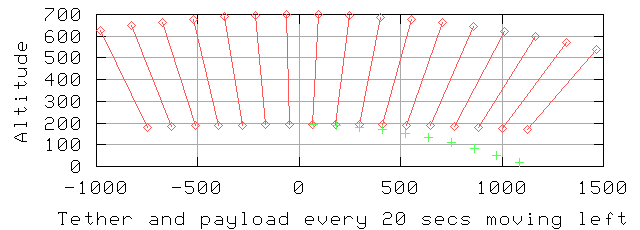Rendezvous
The Soyuz spend days rendezvousing with the Space Station.
A tether demands capture within seconds.
The grapple end of the tether is accelerated upward by the tension in the tether
(about 1.1 Gs) while gravity is pulling the rocket back to Earth (1 G).
So the rocket can match position and velocity with the end of the tether,
but not acceleration. This means the hookup has to
happen fast, like within a second or two. This has not been
demonstrated yet (as of 9/2007) and is clearly non-trivial.
However, there are a few difficult high speed rendezvous that humans have
mastered.
- Airplanes land on
aircraft carriers
even though they are moving
much slower, pitching up and down in the waves, with winds shifting.
- In the early days of spy-sats,
film canisters coming back from space on small parachutes
were snatched out of the air by airplanes.
- In the
Fulton Extraction System a rescue was made by having the
downed pilot let up a helium balloon on a rope and then an airplane
came by and grabbed the rope and pulled the man up into the air.
- Anti-missile missiles
have to get very near a missile coming the
other direction at high speed without any cooperation on tracking
from the other missile.
- Inin-air refueling
- The airport at Courchevel
ski resort is sloped at 18 degrees. Going taking off it is like a ski-jump
and landing is done going uphill.
- Train mail pickup/dropoff. Trains could pickup and drop off mail at 70 MPH using a bar with a hook that turned around when the fast moving package hooked on.
Each of these examples are a bit amazing really.
So while this rendezvous is difficult, with the high speed computers, differential GPS, etc.
that we have today it should be possible. The question is how can we
do it very reliably without too much weight.
We can either transfer the payload from the rocket to the tether or
attach the whole rocket and payload to the tether.
If the rocket is attached to the tether it can go around the
Earth and release when it will be able to glide back to the launch site.
This saves the cost and trouble
of bringing the rocket back to the launch site. The downside is this
takes a stronger tether than if only the payload is attached to
the tether.
Using two stages to get to the tether might be interesting.
The first stage could land very close to the launch site or maybe
even fly back and land at the launch site. The second stage could
be small enough that it could stay attached to the tether and
ride around the Earth without requiring so much more strength
in the tether.

For the rendezvous to work, the rocket has to get to the right place at the
right time with very little room for error. To do this it needs to know
exactly where the tether is and where the rocket is.
A system using the GPS satellites has been shown to have
6.5 meter accuracy during the ballistic phase of a suborbital rocket flight.
With
differential GPS on
the tether and on the rocket we should be able to get much
better. Getting the differential information to both will require
some communications, but we will want this anyway.
It may even be necessary to have a
differential GPS reference station on the tether sending
info to the rocket.
We can also have optical and or radar on the tether and or rocket.
It seems possible to know both positions to within less
than a meter.
The EU plans to have their
Galileo
system up in 2011, which will
be like GPS but with 1 meter accuracy and 10 cm with ground stations.
The US has plans for a
GPS-III
with better than 1 meter accuracy
to be operational around 2012. Far out in space you can not use these
systems, but 100 km high is well below these sats and so they should work fine.
A sort of harpoon gun on the end
of the tether could shoot something on the payload or rocket.
The harpoon could go through a hoop and then spring open when it hits the
payload so it can not be pulled back through the hoop. This could
happen very fast. The computer aiming the harpoon would have to
take into account the different accelerations as it would take a
little time for the harpoon to get to the target.
With something like
this the rocket may just need to get within 50 meters of the
tether so the harpoon can hit the target.
A variation is to shoot a net at the payload that can close very quickly
on the backside of the payload after getting to the payload. The net
would be on a cable so that once it closed around the payload the payload
would be secured.
Click for SpaceTethers.com
Copyright (c) 2002, 2003 by Vincent Cate. All rights reserved.
